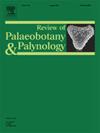重新评估 Altingiaceae 的花粉分化:利用多元统计和机器学习区分落叶(Liquidambar)和常绿(Altingia)类型的挑战
IF 1.7
3区 地球科学
Q2 PALEONTOLOGY
引用次数: 0
摘要
枫香科(Altingiaceae)是木本植物的一个科,由常绿的枫香属(Altingia)和落叶的枫香属(Liquidambar)组成。一些热带的 Altingia 树种只分布在缅甸、泰国、柬埔寨和印度,而没有枫香树;一些温带的枫香树树种只分布在中国北部,而没有 Altingia。根据Altingia-type和Liquidambar-type的分类,它们的花粉化石对重建古气候和历史生物地理具有重要意义。然而,以往区分常绿杏树和落叶枫香树花粉类型的研究结果都是基于有限的花粉标本。在本研究中,我们从广泛收集的标本中获得了关于阿尔廷亚科花粉形态的新发现,并重新评估了区分常绿和落叶类型的诊断特征。为了提高古生态学和古气候解释的可信度,我们对光镜(LM)和扫描电子显微镜(SEM)图像中的花粉大小、气孔数量、花粉壁厚度以及装饰元素的大小和密度进行了多元统计分析。此外,还应用随机森林分类模型测试了区分阿尔廷藤科花粉类型的准确性。我们的研究结果表明,常绿乔木 Altingia 和落叶枫香树 Liquidambar 的花粉在形态上有明显的重叠,分类模型显示出有限的准确性和可解释性。因此,Altingiaceae 的化石花粉不能被确定地划分为常绿或落叶类型,这凸显了在古生态学研究中利用其花粉形态进行分类学划分所面临的挑战。本文章由计算机程序翻译,如有差异,请以英文原文为准。
Reevaluation of pollen differentiation in Altingiaceae: Challenges in distinguishing deciduous (Liquidambar) and evergreen (Altingia) types using multivariate statistics and machine learning
Altingiaceae, a family of woody plants, comprising evergreen Altingia and deciduous Liquidambar groups, exhibits distinct leaf morphology, yet both groups overlap in geographical range and climatic conditions. While some tropical Altingia species are confined to Myanmar, Thailand, Cambodia and India without Liquidambar, and some temperate Liquidambar species to northern China without Altingia. Their fossil pollen have significant implications in reconstructing palaeoclimate and historical biogeography, based on classification of Altingia-type and Liquidambar-type. However, the results of previous studies to differentiate pollen types of evergreen Altingia and deciduous Liquidambar were based on limited pollen specimens. Therefore pollen morphology of Altingiaceae and differentiation of above mentioned types needs reevaluation using more specimens from wider geographical range.
In this study, we present new findings on Altingiaceae pollen morphology from extensive collection of specimens and reassess the diagnostic features to distinguish evergreen and deciduous types. To improve the credibility of palaeoecological and palaeoclimatic interpretations, we applied multivariate statistical analyses to pollen size, number of pores, pollen wall thickness, and size and density of ornamental elements from light microscopy (LM) and Scanning Electronic Microscope (SEM) images. Additionally, random forest classification models were applied to test the accuracy of differentiating Altingiaceae pollen types. Our results reveal significant morphological overlap between the pollen of evergreen Altingia and deciduous Liquidambar, with classification models showing limited accuracy and explainability. Thus, fossil pollen of Altingiaceae cannot be confidently classified into evergreen or deciduous types, highlighting challenges in using their pollen morphology for taxonomic classification in palaeoecological research.
求助全文
通过发布文献求助,成功后即可免费获取论文全文。
去求助
来源期刊
CiteScore
3.50
自引率
21.10%
发文量
149
审稿时长
6 months
期刊介绍:
The Review of Palaeobotany and Palynology is an international journal for articles in all fields of palaeobotany and palynology dealing with all groups, ranging from marine palynomorphs to higher land plants. Original contributions and comprehensive review papers should appeal to an international audience. Typical topics include but are not restricted to systematics, evolution, palaeobiology, palaeoecology, biostratigraphy, biochronology, palaeoclimatology, paleogeography, taphonomy, palaeoenvironmental reconstructions, vegetation history, and practical applications of palaeobotany and palynology, e.g. in coal and petroleum geology and archaeology. The journal especially encourages the publication of articles in which palaeobotany and palynology are applied for solving fundamental geological and biological problems as well as innovative and interdisciplinary approaches.

 求助内容:
求助内容: 应助结果提醒方式:
应助结果提醒方式:


